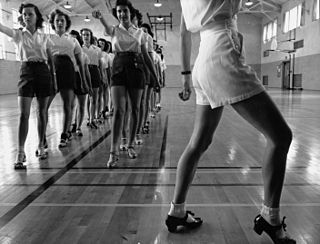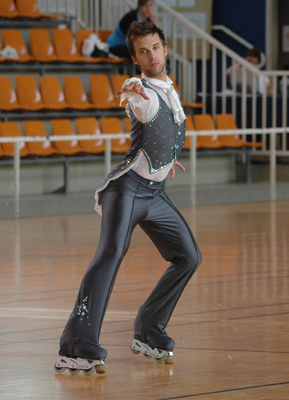
East Coast Swing (ECS) is a form of social partner dance. It belongs to the group of swing dances. It is danced under fast swing music, including lindy hop, rock and roll and boogie-woogie.

Tap dance is a form of dance characterized by using the sounds of tap shoes striking the floor as a form of percussion. Two major variations on tap dance exist: rhythm (jazz) tap and Broadway tap. Broadway tap focuses on dance; it is widely performed in musical theater. Rhythm tap focuses on musicality, and practitioners consider themselves to be a part of the jazz tradition.

Swing dance is a group of social dances that developed with the swing style of jazz music in the 1920s–1940s, with the origins of each dance predating the popular "swing era". Hundreds of styles of swing dancing were developed; those that have survived beyond that era include Lindy Hop, Balboa, Collegiate Shag, and Charleston. Today, the best-known of these dances is the Lindy Hop, which originated in Harlem in the early 1930s. While the majority of swing dances began in African-American communities as vernacular African-American dances, some influenced swing-era dances, like Balboa, developed outside of these communities.

Aerobics is a form of physical exercise that combines rhythmic aerobic exercise with stretching and strength training routines with the goal of improving all elements of fitness. It is usually performed to music and may be practiced in a group setting led by an instructor, although it can be done solo and without musical accompaniment. With the goal of preventing illness and promoting physical fitness, practitioners perform various routines comprising a number of different dance-like exercises. Formal aerobics classes are divided into different levels of intensity and complexity and will have five components: warm-up, cardiovascular conditioning, muscular strength and conditioning, cool-down and stretching and flexibility. Aerobics classes may allow participants to select their level of participation according to their fitness level. Many gyms offer different types of aerobic classes. Each class is designed for a certain level of experience and taught by a certified instructor with a specialty area related to their particular class.
This is a list of dance terms that are not names of dances or types of dances. See List of dances and List of dance style categories for those.
World Rock'n'Roll Confederation (WRRC) was registered in 1984, although its history traces to 1974. It is an umbrella organization for national professional and amateur Rock and Roll dancesport federations. Its statute that it "aims at promoting the physical training of its members by means of sporting activities in the form of Rock'n'Roll dance tournaments, including the acrobatic variations as well as Rock'n'Roll and Boogie Woogie, Lindy Hop, Formation and alternative styles in line with the rules and sporting presentations". The registered office is in Neuhausen am Rheinfall, canton of Schaffhausen, Switzerland.

Boogie-woogie dance is a form of swing dance often done competitively. Although its name derives from the boogie-woogie genre of music, it is most often danced to rock music, but was labeled boogie-woogie because the name rock 'n' roll dance was already in use for a more acrobatic dance sport. The form is cited in Madonna's hit single "Music."

The cha-cha-cha, is a dance of Cuban origin. It is danced to the music of the same name introduced by the Cuban composer and violinist Enrique Jorrin in the early 1950s. This rhythm was developed from the danzón-mambo. The name of the dance is an onomatopoeia derived from the shuffling sound of the dancers' feet when they dance two consecutive quick steps that characterize the dance.

Artistic roller skating is a competitive sport similar to figure skating but where competitors wear roller skates instead of ice skates. Within artistic roller skating, there are several disciplines:
Footwork refers to dance technique aspects related to feet: foot position and foot action.

Footwork is a martial arts and combat sports term for the general usage of the legs and feet in stand-up fighting. Footwork involves keeping balance, closing or furthering the distance, controlling spatial positioning, and/or creating additional momentum for strikes.
The Four Step Brothers were an American dance group. The group started out as a trio in 1925, with the original members, Maceo Anderson, Al Williams and Red Walker. Although their original name was the Step Brothers, because that was also the name of another famous young tap dancing quartet, they subsequently changed their name to "The Three Step Brothers." In 1927, after accepting a new member, Sherman Robinson, they became The Four Step Brothers. Dubbed "The Eight Feet of Rhythm," the group soon traveled with Duke Ellington. While starring with the "Brothers," Anderson also appeared at the Hoofers Club and worked part-time as a newsboy.
The following is a glossary of figure skating terms, sorted alphabetically.
Swedish Dancesport Federation (DSF) administers all dancesport in Sweden. The association was formed on February 25, 1968, and is one of 68 different sports federations in Sweden. DSF became a member of the Swedish Sports Confederation (RF) in 1977, which administers all sports in Sweden. Apart from this membership Swedish Dancesport Federation also is a member of the International Dancesport Federation (IDSF) from June 19, 2011, known as the World DanceSport Federation (WDSF) and the World Rock'n'Roll Confederation (WRRC). The office lies in Farsta, Stockholm.
Discofox or disco fox is a social partner dance which evolved in Europe in the mid-1970s as a rediscovery of the dance hold in the improvisational disco dance scene dominated by solo dancing, approximately at the same time when the hustle emerged in the United States. Both dances were greatly influenced by Saturday Night Fever starring John Travolta. In various regions, it is also known under different names: disco hustle, swing fox, disco swing, and rock fox.
Miguel Angueira was an acrobatic rock'n'roll dancer from France, multiple world champion. Together with his partner Natasha Quoy he has held number one place in the World Rock'n'Roll Confederation ranking list.
British Ice Skating is the national governing body of ice skating within the United Kingdom. Formed in 1879, it is responsible for overseeing all disciplines of ice skating: figure skating ; synchronised skating; and speed skating.
This is a general glossary of the terms used in the sport of gymnastics.








